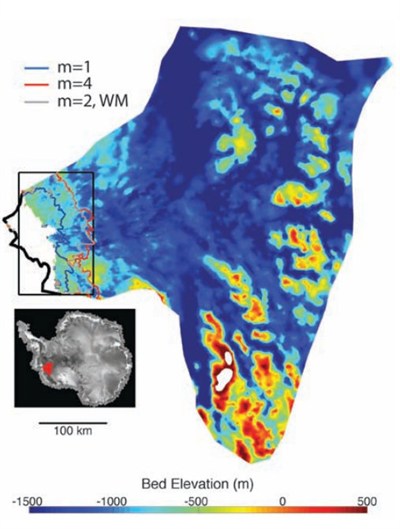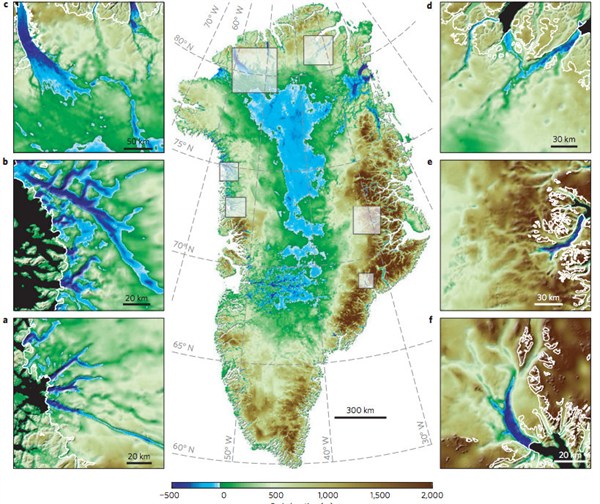Roz Pidcock
20.05.2014 | 5:00pmMelting ice has filled the newspapers over the past couple of weeks, with a deluge of new research into how the planet’s ice cover is being altered by climate change making the headlines.
Coming just a few days after research showing West Antarctic glaciers are in irreversible collapse, today’s news that Antarctic ice melt has doubled in a decade was widely covered.
We’ve taken a look at several new papers that highlight the speed at which earth’s vast ice sheets, glaciers and ice caps are diminishing. Put them all together, and it makes for a stark picture.
1. Antarctic ice melt is twice as fast as ten years ago
‘Antarctic ice losses have DOUBLED in less than a decade with 159 billion tonnes of ice melting each year’, reads today’s Daily Mail headline. The Guardian opts for, ‘Doubling of Antarctic ice loss revealed by European satellite’. The Times says ‘Antarctic melt rate worries scientists’.
All three headlines stem from a paper published yesterday in Geophysical Research Letters, which finds the volume of ice melting into the ocean from Antarctica is twice as large the average between 1992 and 2011, now raising global sea levels by 0.45 millimetres a year.
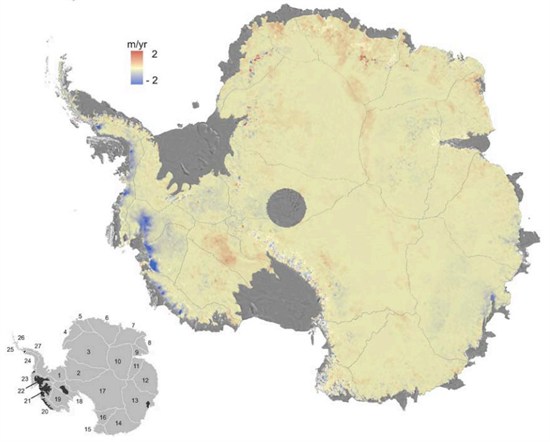
Change in height of ice, as measured by CryoSat-2. Blue shows areas losing ice, red show areas gaining ice in the last three years. The biggest ice loss is in the Amundsen Sea sector (numbers 21 and 22 in inset image. Source: McMillan et al., ( 2014)
The University of Leeds scientists study uses three years of data from the European Space Agency’s CryoSat-2 satellite, launched in 2010. The satellite now sees five times as much area as before, totalling 96 per cent of the total Antarctic continent.
David Vaughan from the British Antarctic Survey told The Guardian why this is so important:
“Through some very clever technical improvements, [the scientists] have produced the best maps of Antarctic ice-loss we have ever had. Prediction of the rate of future global sea-level rise must be begin with a thorough understanding of current changes in the ice sheets – this study puts us exactly where we need to be.”
Across Antarctica, the average height of the ice is dropping by 1.9 centimetres per year, the data shows. East Antarctica is staying roughly the same but West Antarctica is seeing big losses, where ice melt is 31 per cent faster now than between 2005 and 2011. Ice loss from glaciers along the Amundsen coast has tripled over the past two decades, the paper explains.
2. West Antarctic glaciers are collapsing, and it’s “unstoppable”
Eye-catching words like “collapse”, “irreversible”, “unstoppable” and “catastrophic” peppered media coverage last week of two papers charting the demise of West Antarctic glaciers.
The first paper in Science looked at how changes in wind and ocean circulations are bringing warm water in contact with the underside of the Thwaites glacier – one of the biggest in West Antarctica – melting it from the bottom up. Similar things are happening with other glaciers across West Antarctica, explained the second paper in Geophysical Research Letters.
Radar image showing the ice-shelf edge of the Thwaites glacier in West Antarctica (thick black line) and the position of the “grounding line” – where ice meets ocean and goes afloat – under a high warming scenario (red line). Source: Joughin et al,. (2014)
Not only are the glaciers shrinking, but there’s nothing to stop them melting completely. That’s why scientists are talking about the glaciers’ collapse as “irreversible” and “unstoppable”.
And without the huge glaciers to prop up the interior of the ice sheet, much larger areas of West Antarctic ice will start slipping into the ocean. This would ultimately raise sea levels by three to four metres, though that would take several centuries, say the scientists.
Here are some key questions on both bits of research answered by experts.
3. The Greenland ice sheet could melt faster than scientists first thought
The Greenland ice sheet may be more vulnerable to climate change than previously thought, scientists reported in a Nature Geoscience paper on Sunday.
The team of US scientists discovered deep channels extending horizontally below the surface of the Greenland sheet, which mean large parts of the glaciers lie on land that’s below sea level.
Just like in West Antarctic glaciers, warm water coming into contact with the edge of the glacier forms vast pools under the ice sheet, melting it from the bottom up, the paper explains.
Map of Greenland elevation: Ice covered areas that sit below sea level are marked in blue. Smaller images show individual glaciers and submarine trenches. Source: Morlighem et al. ( 2014).
4. Other ice caps and glaciers in the northern hemisphere are melting faster too
As well as the Greenland and Antarctic ice sheets, glaciers and ice caps on land are also melting under the pressure of rising temperatures and contributing to sea level rise.
A new paper published today in the Journal of Climate looks at ice-covered areas greater or equal to 0.5 square kilometres in the Northern Hemisphere, excluding the Greenland Ice Sheet.
The researchers built a model of glacier and ice cap responses to past temperature and snowfall changes, testing it against nearly 1500 measurements from 78 locations worldwide.
The scientists estimated the total contribution to sea-level rise from ice caps and glaciers was 0.51 millimetres per year between 1979-2009. But it’s speeding up – looking just at the recent decade, 1999-2009, the contribution is 40 per cent higher, at around 0.71 millimetres per year.
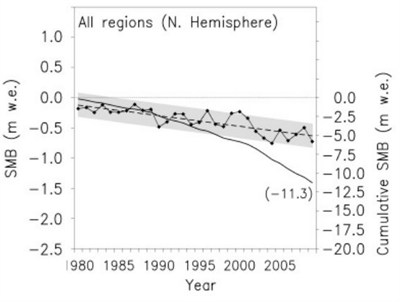
Surface mass balance of ice caps and glaciers in the northern hemisphere – excluding the Greenland Ice Sheet – showing a loss (dashed line) between 1970 and 2009. Annual values are marked by black circles. The solid black line is the cumulative ice loss over the period. Source: Mernild et al., ( 2014)
5. Soot from forest fires contributed to unusually large Greenland surface melt in 2012
Finally, a new study published today explores the reasons for why an unusually large amount of the surface of the Greenland ice sheet melted in 2012. This exceptional summer saw more than 97 percent melt away, far more than the next biggest event almost a century before in 1889.
The team of US scientists examined the layers of ice and snow in six ice cores, concluding that a combination of exceptionally high temperatures and soot from northern hemisphere forest fires, known as black carbon, drove unusually extensive surface melt in both cases.
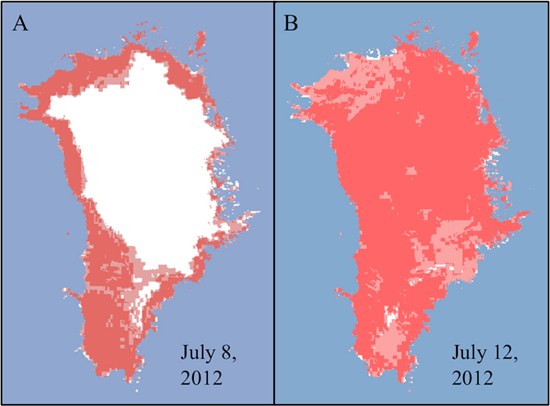
Greenland surface melt on two separate days in July 2012, the latter after high temperatures and soot from forest fires triggered widespread melting. Image courtesy of Dorothy Hall, NASA/GSFC. Source: Keegan et al., ( 2014)
Surface melting doesn’t contribute to sea level rise because the water percolates back into the snow and refreezes. But it does reduce the reflectivity of the ice, known as albedo, with consequences for how much sunlight the Arctic region absorbs, and how much ice stays frozen.
Together, with soot which also decreases reflectivity, the ice albedo was pushed below a certain threshold in 1889 and 2012, making it vulnerable to rapid ice loss, say the authors. Lead author Kaitlin Keegan explains such big surface melting events won’t be out of place by 2100:
“With both the frequency of forest fires and warmer temperatures predicted to increase with climate change, widespread melt events are likely to happen much more frequently in the future.”


